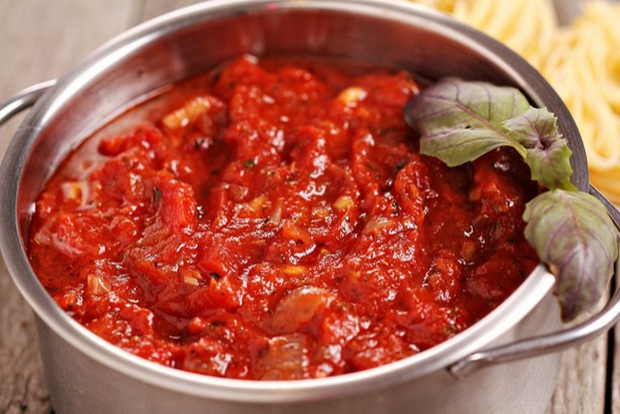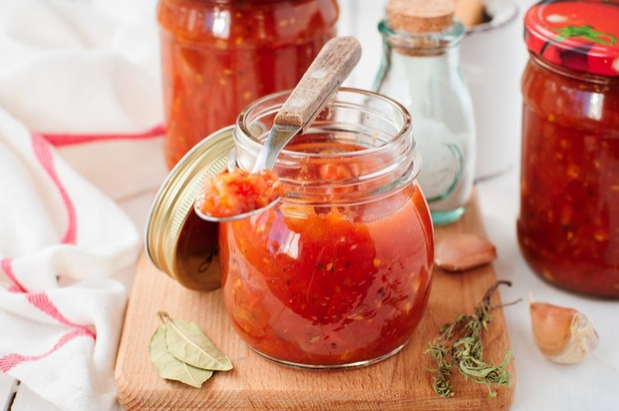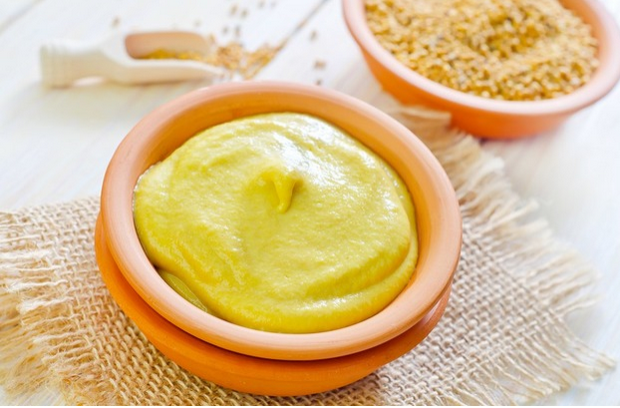HOT SAUCES WITH YOUR HANDS. TASTY,
In addition, savory sauces tend to be very healthy. And it's all about the burning ingredients that warm the body from the inside and are an excellent means of preventing and treating colds and viral diseases.
In addition, some of them effectively strengthen the immune system and even help get rid of extra centimeters at the waist and fight cancer cells.
Here are 6 interesting recipes for savory sauces that can be a great addition to a variety of dishes on your table.

RED TABASCO
Red Tabasco is rightfully considered the leader among scalding sauces. Cult sauce originally from America pleases all lovers of something hot for a good century and a half. And it does not lose its relevance. The sauce goes well with meat dishes, fish, vegetable stews, pizza, seafood, omelettes and marinades. The main thing is not to overdo it. Red Tabasco is really hot.
Make red tabasco at home. Take 6 dry chili peppers, cut them in half, remove the seeds, membranes and stems. Better to be wearing gloves. Cut the chili into small pieces, put in a saucepan and pour boiling water over it, leave for half an hour.
At this time, prepare the rest of the ingredients: peel 4 ripe tomatoes, chop and, together with 1 onion and 2 cloves of garlic that need to be peeled, pass through a meat grinder or chop in a blender, adding softened pepper with a little water. Heat 2 tablespoons of olive oil in a saucepan, add the resulting puree and chopped parsley. Boil the sauce until it thickens. At the end, add sugar, 1 tablespoon of vinegar, pepper and salt.

GREEN TABASCO
Hot Tabasco is not only red, but also green. This option, unlike its classic counterpart, is made from green jalapeno peppers. By the way, green Tabasco tastes much softer than red. This sauce goes well with avocado dishes, guacamole, burgers, omelettes and vegetables.
Grab some green hot jalapeno peppers. Cut them into plates and place them in warm water for a while so that they are cleaned of excess seeds. Then send the jalapenos to a blender. Add wine vinegar so that the peppers are 3/4 covered. Salt to taste. You can add a little garlic, which will make the sauce even hotter and more vigorous.
Blend lightly in a blender. Then bring the resulting mixture to a boil and reduce the heat. On low heat, green Tabasco should be boiled for about an hour, stirring constantly. Cool the sauce and blend again in a blender until the desired consistency. Store Tabasco in a cool place.

ADJIKA
Hot sauce gave the peoples of the Caucasus many interesting flavor combinations. So, adjika is ideal for meat. You can use this sauce with soups, and with vegetables, such as beans. Adjika also has healing properties. It is an excellent antimicrobial agent. Adjika also dilates blood vessels and stimulates blood circulation.
It is best to cook adjika at home with rubber gloves, because the ingredients burn both literally and figuratively. Take 500 grams of hot pepper, rinse it and cut off the tails. Seeds may not be removed. Peel 100 grams of garlic, removing the husk from it and cutting off the bases. Dry 100 grams of walnuts in a frying pan, having previously cleaned of excess husks.
Pass the pepper through a meat grinder with a fine mesh. Garlic, nuts and coriander should also be crushed. Having combined 2 mixtures, pass through a meat grinder a couple more times so as to achieve a uniform consistency. Wash the greens, dry and finely chop with a sharp knife. Combine all ingredients, add salt and mix thoroughly. Cover adjika and ideally leave it alone for 3 days. Then pour into jars and refrigerate.

SALSA
Mexican salsa sauce is an essential ingredient in national dishes. No burrito and no tortilla, as well as fried meats and other Latin American dishes, are complete without burning salsa.
To prepare salsa at home, you only need to arm yourself with all the ingredients. Take 3 large ripe tomatoes, 1 red chilli, 2 garlic cloves, 1 small chopped onion, a bunch of cilantro and salt.
In a heavy bottomed pan, preheat the oil and then sauté the garlic, chillies and tomatoes for 10 minutes. Then transfer the mixture to a blender, add cilantro, salt and beat lightly. It is important to consider that it is worth whisking the salsa just lightly, since the consistency of the sauce should not be too homogeneous.

WASABI
Japanese hot seasoning is made from wasabi horseradish. This sauce is traditionally served with sushi, rolls and sashimi. Wasabi has a pronounced anti-inflammatory effect and strengthens the immune system. In addition, wasabi disinfects food, promotes detoxification of the body, inhibits the growth of bacteria and increases vitality.
Cooking Japanese seasoning at home. Unfortunately, acquiring freshly grated wasabi root is an almost impossible task. Therefore, in Europe, preference is given to a special wasabi powder, which is sold in large or specialized stores. To get a thick consistency of wasabi, you need to mix 1 teaspoon of powder with 1 teaspoon of warm water. Mix well.

MUSTARD
Mustard is in no way inferior to its counterparts and, along with other hot sauces, has medicinal and healing properties. So, it starts metabolic processes in the body, improves the functioning of the gastrointestinal tract, fights microbes and viruses. Try using mustard as a meat marinade. It will be incredibly soft. A salad is best seasoned with a mixture of mustard and olive oil. Very tasty and spicy.
Dilute 3 tablespoons of mustard powder with boiling water and mix well until a fairly thick mass forms. Top with cold water so that its layer exceeds the mustard mass by 3 centimeters. Without stirring, put the container in the refrigerator or other cool place for about 12 hours. After this time, drain the top layer and add seasoning.
Seasoning is prepared simply: take 2 tablespoons of vegetable oil, add 1 tablespoon of granulated sugar and a pinch of salt to it. Mix well and only after that add 2 tablespoons of vinegar. Stir thoroughly again. And then put the mustard in the refrigerator for another day, so that all the excess bitterness is gone from it.





